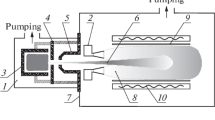Abstract
The data of investigations on the physicochemical and electrophysical properties of borophosphosilicate glass layers deposited from mixtures of tetraethoxysilane and esters of boric and phosphoric acids in an oxygen-ozone medium (temperature, 400–440°C; atmospheric and subatmospheric pressures) have been generalized. The empirical relationships are obtained for determining the boundaries of the optimum dopant concentration region when the glass is used as a reflow interlayer dielectric in integrated circuit technology. The assumption is made that the structure of borophosphosilicate glass layers is formed by a porous network involving dopant clusters.
Similar content being viewed by others
References
Ramiller, C. and Yau, L., Borophosphosilicate Glass for Low Temperature Reflow,Proc. SEMCON/WEST’82, San Mateo (USA), 1982, pp. 29–37.
Kern, W. and Schnable, G.L., Chemically Vapor-Deposited Borophosphosilicate Glasses for Silicon Device Applications,RCA Rev., 1982, vol. 82, no. 3, pp. 423–457.
Dukhanova, T.G., Vasil’ev, V.Yu., and Veretenin, Yu.I., Preparation, Properties, and Application of Borophos-phorosilicate Glass Layers in Integrated Circuit Technology,Obzory Elektron. Tekh., Ser. 3, Moscow: TsNII “Elektronika,” 1988, issue 4, pp. 1–72.
Vassiliev, V.Y., Modern BPSG Film Technology,Visual Booklet of Short Courses at IV Int. Dielectric for ULSI Multilevel Interconnection Conf., Santa Clara (USA), 1998, pp. 111–192.
Fujino, K., Nishimoto, Y., Tokumasu, N., and Maeda, K., TEOS and Ozone Atmospheric Pressure CVD of Borophosphosilicate Glass Films Using Triethylborate and Trimethylphosphate,J. Electrochem. Soc., 1993, vol. 140, no. 10, pp. 2922–2927.
Robles, S., Russel, K., Galiano, M., Kithcart, V., and Nguen, B.C., Gap Fill and Film Reflow Capability of Subatmospheric Chemical Vapor Deposited Borophosphosilicate Glass,J. Electrochem. Soc., 1996, vol. 143, no. 4, pp. 1414–1421.
Vassiliev, V.Y. and Zheng, J.Z., The Investigation on the Deposition Kinetics of Sub-Atmospheric Pressure Glass Films,Proc. VII Int. Symp. IC Technology, Singapore, 1997, pp. 522–525.
Vassiliev, V.Y., Zheng, J.Z., Liao, M., and Lin, Y.S., Step Coverage and Gap-Fill Properties of Sub-Atmospheric and Atmospheric Pressure TEOS-Ozone Borophosphosilicate Glass Films,Proc. IV Int. Dielectric for ULSI Multilevel Interconnection Conf., Santa Clara (USA), 1998, pp. 90–7.
Tang, S.K., Vassiliev, V.Y, Mridha, S., and Chan, L., Investigation of Borophosphosilicate Glass Roughness and Planarization with the Atomic Force Microscope Technique,Abstracts of Papers, XXV Int. Conf. on Metallurgical Coatings and Thin Films (ICMCTF-98), San Diego (USA), 1998, p. 144.
Zheng, J.-Z., Huang, S.K., Lu, W., Vassiliev, V.Y., Feng, C., Zhou, B.B., and Tay, W.S., Integration of Sub-Atmospheric Pressure BPSG with CMP for Pre-Metal Dielectric of 0.35 Μm Technology,Proc. V Ann. Tech. Symp. on IC Technology (SEMICON 97), Singapore, 1997, pp. 269–73.
Lu, W., Vassiliev, V.Y, Zheng, J.Z., and Chan, L., Comparison of Sub-Atmospheric BPSG Films with Plasma Enhanced BPSG Films,Proc. III. Int. Dielectric for ULSI Multilevel Interconnection Conf, Santa Clara (USA), 1997, pp. 219–22.
Lu, W., Vassiliev, V.Y, and Zheng, J.Z., Flow Properties of Subatmospheric Pressure BPSG Films with Thick Cap-Layer,Proc. XV Int. VLSI Multilevel Interconnection Conf., Santa Clara (USA), 1998, pp. 300–07.
Vassiliev, V.Y., Lu, W., Zheng, J.Z., Wang, H.R., and Chan, L., The Formation and Growth of Surface Defects in Sub-Atmospheric Pressure BPSG Films,Proc. III Int. Dielectric for ULSI Multilevel Interconnection Conf., Santa Clara (USA), 1997, pp. 219–22.
Vassiliev, V.Y., Lu, W., Zheng, J.Z., and Lin, Y.S., The Removal and Suppression of Surface Defects in Sub-Atmospheric Pressure BPSG Films,Proc. XIV Int. VLSI Multilevel Interconnection Conf., Santa Clara (USA), 1997, p. 538.
Vassiliev, V.Y. and Zheng, J.Z., The Analysis of Optimized Dopant Concentration Range in Borophosphosilicate Glass Films for VLSI and ULSI,Proc.—Electrochem. Soc. (Pennington, NJ), 1997, vol. 97-25, pp. 1199–1206.
Tang, S.K., Mridha, S., Vassiliev, V.Y., Zheng, J.Z., and Chan, L., Characterization of Surface Defects in the Sub-Atmospheric Pressure-CVD Borophosphosilicate Glass Films on Silicon Wafer,Proc. VII Int. Symp. IC Technology, Singapore, 1997, pp. 601–04.
Tang, S.K., Vassiliev, V.Y., Mridha, S., and Chan, L., Investigation of Borophosphosilicate Glass Defects with the Atomic Force Microscope,Abstracts of Papers,XLIV Int. Symp. Am. Vac. Soc., San Jose (USA), 1997, p. 189.
Tang, S.K., Vassiliev, V.Y., Mridha, S., and Chan, L., Formation of the Solid State Defects in Chemically Vapor Deposited Borophosphosilicate Glass Films,Proc. IV Int. Dielectric for ULSI Multilevel Interconnection Conf., Santa Clara (USA), 1998, pp. 287–90.
Loiko, K.V., Vassiliev, V.Y., Chua, C.T., and Lim, D.H.Y, The Electrical Properties of Chemical Vapor Deposited Silicon Oxide Films for Applications as Interlayer Dielectrics in ULSI,Proc. Int. Conf. on Electrical Insulation and Dielectric Phenomena, Minnesota (USA), 1997, pp. 150–153.
Vassiliev, V.Y., Tang, S.K., Zheng, J.Z., and Liao, M., Application of Surface Charge Analysis Technique for Fast Non-Destructive Characterization of Sub-Atmospheric Pressure TEOS-Ozone BPSG Films,Proc. IV Int. Dielectric for ULSI Multilevel Interconnection Conf., Santa Clara (USA), 1998, pp. 253–60.
Levy, R.A. and Kometani, T.Y., Analysis of Borophosphosilicate Glass Films by Inductively Coupled Plasma-Atomic Emission Spectroscopy,J. Electrochem. Soc., 1987, vol. 134, no. 6, pp. 1565–1567.
Vasil’ev, V.Yu. and Dukhanova, T.G., Vapor Phase Deposition and Properties of Borophosphorosilicate Glass Layers,Khim. Fiz., 1992, vol. 11, no. 12, pp. 1699–1710.
Kamieniencki, E., Determination of Surface Space Charge Using a Light Probe,J. Vac. Sci. Technol., 1982, vol. 20, no. 3, pp. 811–814.
Lipkin, L., Real-Time Oxidation Monitoring with a Surface Charge Analyzer,J. Electrochem. Soc., 1993, vol. 140, no. 8, pp. 2328–2332.
Yoshimaru, M. and Matsuhashi, H., Moisture Resistance of Annealed Borophosphosilicate Glass Films for Very Large Scale Integrated Circuit Applications,J. Electrochem. Soc., 1996, vol. 143, no. 9, pp. 3032–3037.
Nauka, K. and Liu, C., Suppression of Water Absorption in Borophosphosilicate Glass Thin Layers with High Boron Concentration,J. Electrochem. Soc., 1991, vol. 138, no. 8, pp. 2367–2370.
Vasil’ev, V.Yu. and Dukhanova, T.G., Investigation on the Planarization of Integrated Circuit Relief upon Reflow of Borophosphorosilicate Glass,Elektron. Tekh.,Ser.3, 1991, no. 4, pp. 38–41.
Author information
Authors and Affiliations
Rights and permissions
About this article
Cite this article
Vasil’ev, V.Y. Properties of vapor-deposited borophosphorosilicate glass layers employed in technology of silicon integrated circuits. Glass Phys Chem 26, 83–92 (2000). https://doi.org/10.1007/BF02731948
Received:
Accepted:
Issue Date:
DOI: https://doi.org/10.1007/BF02731948




